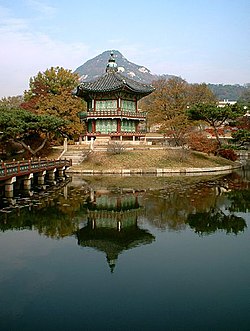| Gyeongbokgung | |
|---|---|
 | |
| Korean name | |
| Hangul: | 경복궁 |
| Hanja: | 景福宮 |
| Revised Romanization: | Gyeongbokgung |
| McCune-Reischauer: | Kyŏngbokkung |
Gyeongbokgung (Gyeongbok Palace) is a palace located in northern Seoul, South Korea. It was the main and largest palace of the Joseon Dynasty and one of the Five Grand Palaces built by the Joseon Dynasty.
The palace was originally constructed in 1394 by Jeong Do-jeon, a Korean architect. Parts of the palace were burnt down during the Japanese invasion in 1592. After years of neglect and failure to restore it due to the sheer size of the logistics involved, it was reconstructed during 1860s as a massive 330 building complex with 5,792 rooms. Standing on 410,000 square meters of land, it was a symbol of majesty for the Korean people and the home of the royal family. Soon after the assassination of Empress Myeongseong by the Japanese agents in 1895, her husband, Gojong of Korea left the palace and the Imperial family would never return to the palace.
In 1911, the Japanese occupiers destroyed all but 10 buildings during its occupation of Korea, constructing the Japanese General Government Building for the Governor-General of Korea in front of the throne hall, deliberately disrupting the geomancy of Seoul. Oddly, Japan took various pictures of poverty in Korea but did not take a single photograph of this historical site before its destruction. Many Korean historians who wish to know the exact layout, color and design have searched endlessly in Japan and other nations who took photos of Seoul prior to the palaces destruction.
The major buildings on the site include Geunjeongjeon, the Imperial throne room (national treasure number 223), and Gyeonghoeru Pavilion (national treasure number 224), which stands in an artificial lotus lake and rests on 48 granite pillars. The pavilion is depicted on the Korean banknotes of 10,000 won.
Today the palace is open to the public, and the National Folk Museum of Korea is located on the site. The National Museum of Korea was there too, until it was relocated to Yongsan-gu in 2005.
Many Koreans still hope to resurrect part of the original palace. Archeological work has brought 330 building foundations to light. However, the exact design, color, height, etc may never truly be determined.
No comments:
Post a Comment